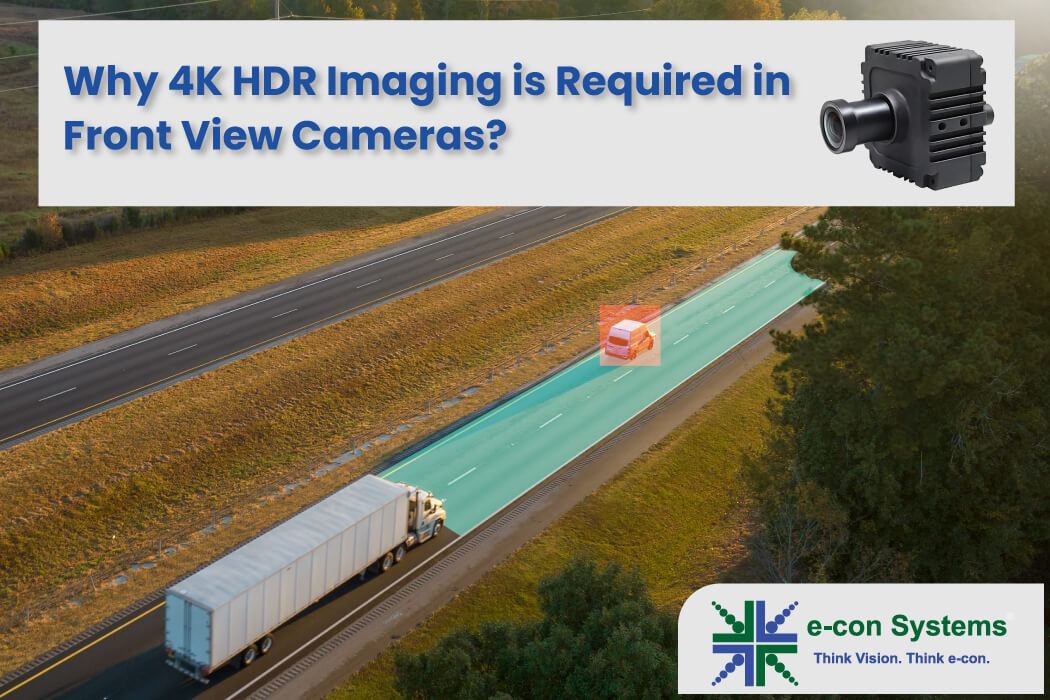In mobility systems that rely on visual intelligence, forward-facing cameras are expected to do what human eyes often struggle with—detect, classify, and respond to dynamic traffic conditions under inconsistent lighting, high motion, and structural unpredictability. Whether it’s interpreting a road sign partially obscured by shadow or distinguishing between a pedestrian and a pole, the camera’s input becomes the starting point for every decision.
In this blog, you’ll find out why 4K HDR imaging is no longer optional for forward-facing cameras by examining five critical tasks required in assisted and autonomous driving.
Importance of 4K Cameras in Mobility Applications
In mobility applications, environmental unpredictability is rather common. So, forward-facing cameras must operate under high-speed motion, rapidly changing light, LED-heavy signage, and dense visual noise. Under these conditions, standard sensors struggle to retain critical detail, especially at longer ranges or across varying contrast zones.
Thanks to 4K cameras, mobility applications can capture broader scenes without sacrificing per-pixel sharpness. Combined with HDR, this enables consistent image quality across highlights and shadows. Imaging consistency is maintained even when glare, reflections, or motion blur are present. The result is a dependable imaging feed that supports timely, accurate decisions in real-world driving environments.
Use Cases of 4K Cameras in Mobility Applications
Detecting obstacles in real time
Obstacle detection goes beyond identifying a static barrier ahead. It involves a series of micro-interpretations per frame: speed, distance, trajectory, and type. Therefore, a forward-facing camera must see a large object across the road while distinguishing if it’s a shadow, a pothole, a pedestrian mid-stride, or a moving vehicle crossing laterally.
4K resolution also helps provide broader horizontal and vertical coverage without compromising per-pixel detail. Hence, neural networks can track finer features like object edges, movement blur, and surface contrast: all of which are crucial to determine object class and urgency.
HDR imaging also becomes critical when the obstacle is partially or fully in shadow. For example, a cardboard box in a shaded lane or a cyclist under a tree canopy may go undetected by conventional sensors. A 140 dB HDR pipeline can recover detail across shadow and highlight zones, thereby preventing missed detections that result from exposure bias.
Reading road signs and lane markings
Most road signs are designed for human perception. That doesn’t always translate well to embedded vision. Dirt, sun glare, edge fading, and non-standard mounting angles can affect machine readability. Add motion to that (think 80 km/h or more), and the need for resolution density becomes clear.
With a 4K sensor, road signs can be captured at greater distances, giving more inference time for AI models to classify, verify, and respond. The added pixel density helps in parsing small fonts, faded edges, and occlusions that might otherwise trigger false negatives in recognition models.
HDR helps recover contrast in overlit or backlit conditions. Think of a speed-limit board directly under the sun or reflective signs at dusk. Without HDR, these frames would be overexposed or whitewashed, rendering the image unusable for inference.
Tracking pedestrians, cyclists, vehicles, and more
This task is about temporal continuity: recognizing objects across frames, under changing angles, speeds, and distances. Low-resolution sensors introduce a delay in identity retention (especially when zoomed out), increasing the likelihood of tracker failure.
4K imaging reduces this by offering more anchor points per object. A pedestrian’s limbs, a cyclist’s motion pattern, or a vehicle’s license plate region can all be extracted more reliably, allowing multi-frame tracking algorithms to operate with greater consistency. For instance, a cyclist emerging from the side of a truck or a person stepping out of a shadow can be detected with fewer dropped frames.
Anticipating traffic behavior at intersections
Intersections are among the most complex spaces in any mobility grid. Multiple lanes, crisscrossing objects, road paint with varied reflectivity, changing lighting angles, and occlusions caused by large vehicles, all converge in a small physical footprint. The camera needs to interpret all of this information quickly while avoiding loss in compositional detail.
A 4K HDR camera helps deconstruct intersections by retaining image sharpness across both the depth and breadth of the scene. Details like brake light reflections, side mirror flickers, or brief pedestrian appearances can be maintained across frames and light levels.
Dynamic range is important here as intersections involve transitional lighting like part shadow, part sun, or high-beam glare. A 140 dB HDR sensor adjusts exposure on a per-pixel basis, making it possible to capture usable data across light gradients.
Responding to LED-based traffic signals
LED flicker is a known problem in camera systems. When the refresh rate of the LED is out of sync with the camera’s exposure timing, the signal may either disappear entirely or appear inconsistent across frames. It poses a high risk for mobility systems that depend on clear state transitions: red to green, blinking amber, or flashing pedestrian icons.
The need of the hour is LED Flicker Mitigation (LFM), supported by a capable HDR sensor and a fine-tuned ISP. When paired with 4K, the benefits include the detection of small icon-based indicators, clear rendering of low-contrast lights, and more frames per transition cycle.
In forward-facing cameras like STURDeCAM88, the combination of 4K + HDR + LFM provides redundancy in signal recognition. Vehicles can easily act based on reliable visual confirmation rather than predictive logic alone.
e-con Systems’ World-Class Forward-Facing Cameras for Mobility Applications
Since 2003, e-con Systems® has been designing, developing, and manufacturing OEM cameras. Our extensive portfolio includes IP69K-rated, automotive-grade cameras for mobility applications. They meet compliance benchmarks such as RoHS 3, REACH, AEC-Q100 Grade 2, etc.
One of our latest releases is STURDeCAM88, our GMSL2-based 4K HDR camera for forward-facing applications. Based on OmniVision’s OX08B40 sensor, this camera offers 140dB HDR and LED Flicker Mitigation for consistent imaging under harsh lighting and LED sources. It comes with an IP67-rated enclosure and a factory-aligned M12 lens for field-ready deployment.
Browse our Camera Selector Page to view our complete portfolio.
Need expert help in finding and deploying the perfect camera for your vision system? Get in touch with us by writing to camerasolutions@e-consystems.com.

Suresh Madhu is the product marketing manager with 16+ years of experience in embedded product design, technical architecture, SOM product design, camera solutions, and product development. He has played an integral part in helping many customers build their products by integrating the right vision technology into them.




